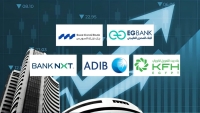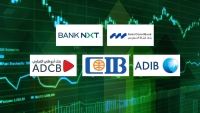Egyptian Banks’ capital ratios can ride out fresh EGP devaluation: Fitch Ratings

Egyptian banks’ regulatory capital ratios can hold out against further devaluation of the Egyptian pound as they are supported by healthy internal capital generation according to Fitch Ratings.
However, Fitch noted that large private-sector banks are better-placed to withstand currency depreciation than the two largest public-sector banks, National Bank of Egypt (NBE) and Banque Misr (BM), due to their higher regulatory capital buffers.
The Egyptian pound has weakened 16% against the US dollar so far this year, and by about 40% since end-June 2022.
In addition, Fitch ratings predicted that the currency may remain under pressure in 2023 given Egypt’s import backlog, estimated at USD5.4 billion (16% of FX reserves), and large gross external funding needs, estimated at over USD19 billion for 2023 (about 60% of FX reserves). It remains to be seen whether the Central Bank of Egypt will let the exchange rate and interest rates adjust sufficiently to attract new portfolio flows.
Fitch Ratings-London-17 January 2023: Egyptian banks’ regulatory capital ratios can withstand further Egyptian pound depreciation as they are supported by healthy internal capital generation, Fitch Ratings says. Large private-sector banks are better-placed to withstand currency depreciation than the two largest public-sector banks, National Bank of Egypt (NBE) and Banque Misr (BM), due to their higher regulatory capital buffers.
The Egyptian pound has weakened 16% against the US dollar so far this year, and by about 40% since end-June 2022. The currency may remain under pressure in 2023 given Egypt’s import backlog, estimated at USD5.4 billion (16% of FX reserves), and large gross external funding needs, estimated at over USD19 billion for 2023 (about 60% of FX reserves). It remains to be seen whether the Central Bank of Egypt will let the exchange rate and interest rates adjust sufficiently to attract new portfolio flows.
Some Egyptian banks keep moderate long open-currency positions, which can lead to pressure on capital ratios due to inflation of foreign-currency (FC) denominated risk-weighted assets (RWA). FC assets accounted for 37% of RWA on average at the five largest banks at end-1H22.
Assuming a 100% risk-weight for most FC assets, Fitch estimated that a 10% currency depreciation would erode banks’ common equity Tier 1 (CET1) ratios by 30bp, on average Yet, Fitch estimated that FC RWA have inflated by about 60% since end-1H22.
Fitch Ratings-London-17 January 2023: Egyptian banks’ regulatory capital ratios can withstand further Egyptian pound depreciation as they are supported by healthy internal capital generation, Fitch Ratings says. Large private-sector banks are better-placed to withstand currency depreciation than the two largest public-sector banks, National Bank of Egypt (NBE) and Banque Misr (BM), due to their higher regulatory capital buffers.
The Egyptian pound has weakened 16% against the US dollar so far this year, and by about 40% since end-June 2022. The currency may remain under pressure in 2023 given Egypt’s import backlog, estimated at USD5.4 billion (16% of FX reserves), and large gross external funding needs, estimated at over USD19 billion for 2023 (about 60% of FX reserves). It remains to be seen whether the Central Bank of Egypt will let the exchange rate and interest rates adjust sufficiently to attract new portfolio flows.
Some Egyptian banks keep moderate long open-currency positions, which can lead to pressure on capital ratios due to inflation of foreign-currency (FC) denominated risk-weighted assets (RWA). FC assets accounted for 37% of RWA on average at the five largest banks at end-1H22. Assuming a 100% risk-weight for most FC assets, we estimate that a 10% currency depreciation would erode banks’ common equity Tier 1 (CET1) ratios by 30bp, on average. We estimate that FC RWA have inflated by about 60% since end-1H22.
CIB’s (‘B+’/Negative) and QNB Al Ahli’s (QNB AA; not rated) CET1 ratios are the most sensitive to currency depreciation. It is estimated that the 60% depreciation will have reduced their CET1 ratios by about 500bp and 300bp, respectively. However, despite this, both banks still have strong regulatory capital buffers.
Furthermore, NBE and BM had the weakest CET1 ratios at end-1H22. Both banks are rated ‘B+’/Negative and have a ‘b-’ capitalisation and leverage score. However, it is estimated the ratios will remain above the 4.5% minimum requirement, even without factoring in subsequent profits. In addition, Fitch predicted annualised 1H 22 net incomes, if fully retained, would add 220bp and 190bp to NBE’s and BM’s ratios, respectively.







